Research on Financial Performance of Airlines
VerifiedAdded on 2023/04/17
|10
|3787
|273
AI Summary
This research focuses on the financial performance of airlines and the factors that have influenced their success or failure. It analyzes the performance of top performing airlines like Ryanair and easyJet compared to struggling airlines like Air France-KLM. The study also examines the characteristics of low-cost carriers and full-scale carriers, as well as the external factors that have impacted the industry. The research covers the period between 2004 and 2013 and aims to provide insights into the dynamics of the airline industry.
Contribute Materials
Your contribution can guide someone’s learning journey. Share your
documents today.
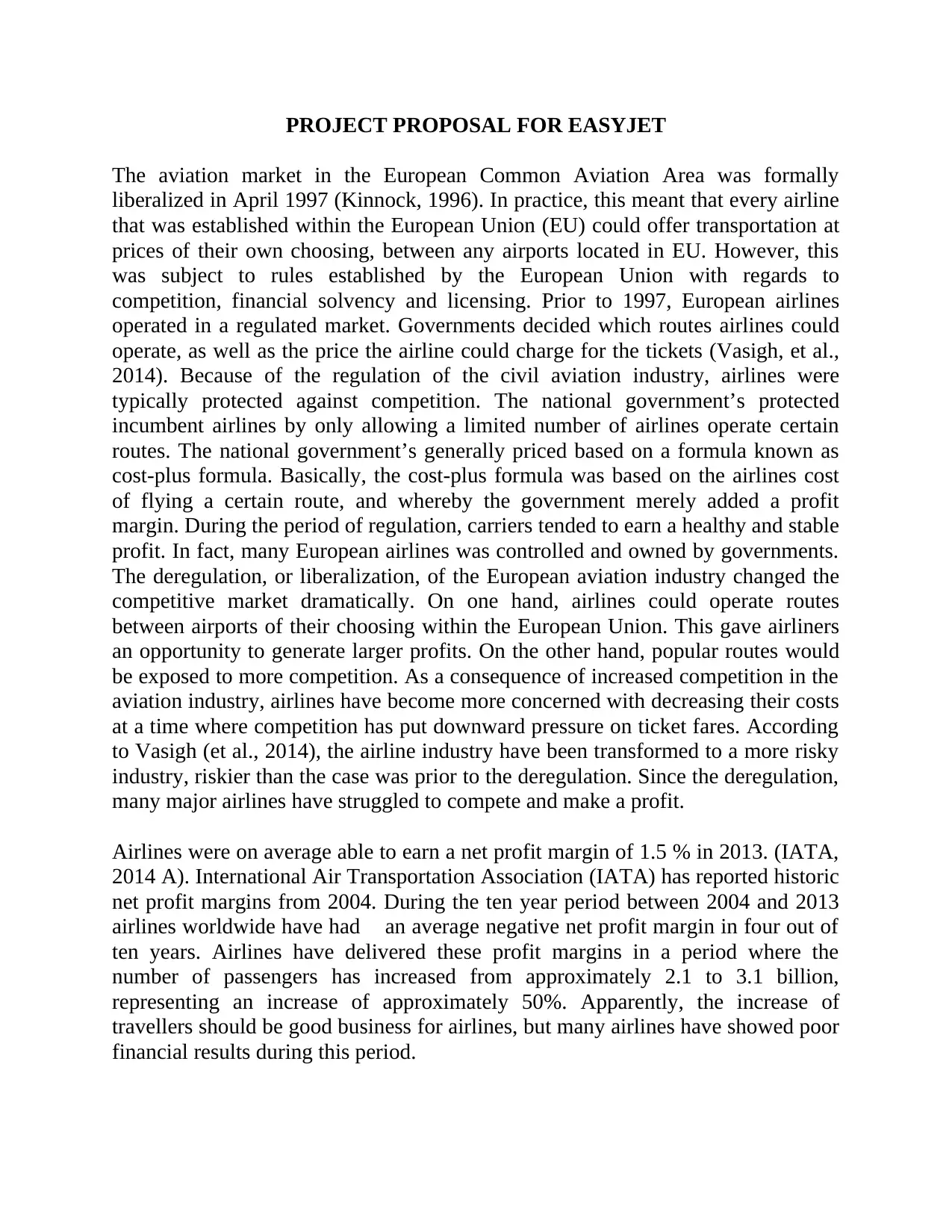
PROJECT PROPOSAL FOR EASYJET
The aviation market in the European Common Aviation Area was formally
liberalized in April 1997 (Kinnock, 1996). In practice, this meant that every airline
that was established within the European Union (EU) could offer transportation at
prices of their own choosing, between any airports located in EU. However, this
was subject to rules established by the European Union with regards to
competition, financial solvency and licensing. Prior to 1997, European airlines
operated in a regulated market. Governments decided which routes airlines could
operate, as well as the price the airline could charge for the tickets (Vasigh, et al.,
2014). Because of the regulation of the civil aviation industry, airlines were
typically protected against competition. The national government’s protected
incumbent airlines by only allowing a limited number of airlines operate certain
routes. The national government’s generally priced based on a formula known as
cost-plus formula. Basically, the cost-plus formula was based on the airlines cost
of flying a certain route, and whereby the government merely added a profit
margin. During the period of regulation, carriers tended to earn a healthy and stable
profit. In fact, many European airlines was controlled and owned by governments.
The deregulation, or liberalization, of the European aviation industry changed the
competitive market dramatically. On one hand, airlines could operate routes
between airports of their choosing within the European Union. This gave airliners
an opportunity to generate larger profits. On the other hand, popular routes would
be exposed to more competition. As a consequence of increased competition in the
aviation industry, airlines have become more concerned with decreasing their costs
at a time where competition has put downward pressure on ticket fares. According
to Vasigh (et al., 2014), the airline industry have been transformed to a more risky
industry, riskier than the case was prior to the deregulation. Since the deregulation,
many major airlines have struggled to compete and make a profit.
Airlines were on average able to earn a net profit margin of 1.5 % in 2013. (IATA,
2014 A). International Air Transportation Association (IATA) has reported historic
net profit margins from 2004. During the ten year period between 2004 and 2013
airlines worldwide have had an average negative net profit margin in four out of
ten years. Airlines have delivered these profit margins in a period where the
number of passengers has increased from approximately 2.1 to 3.1 billion,
representing an increase of approximately 50%. Apparently, the increase of
travellers should be good business for airlines, but many airlines have showed poor
financial results during this period.
The aviation market in the European Common Aviation Area was formally
liberalized in April 1997 (Kinnock, 1996). In practice, this meant that every airline
that was established within the European Union (EU) could offer transportation at
prices of their own choosing, between any airports located in EU. However, this
was subject to rules established by the European Union with regards to
competition, financial solvency and licensing. Prior to 1997, European airlines
operated in a regulated market. Governments decided which routes airlines could
operate, as well as the price the airline could charge for the tickets (Vasigh, et al.,
2014). Because of the regulation of the civil aviation industry, airlines were
typically protected against competition. The national government’s protected
incumbent airlines by only allowing a limited number of airlines operate certain
routes. The national government’s generally priced based on a formula known as
cost-plus formula. Basically, the cost-plus formula was based on the airlines cost
of flying a certain route, and whereby the government merely added a profit
margin. During the period of regulation, carriers tended to earn a healthy and stable
profit. In fact, many European airlines was controlled and owned by governments.
The deregulation, or liberalization, of the European aviation industry changed the
competitive market dramatically. On one hand, airlines could operate routes
between airports of their choosing within the European Union. This gave airliners
an opportunity to generate larger profits. On the other hand, popular routes would
be exposed to more competition. As a consequence of increased competition in the
aviation industry, airlines have become more concerned with decreasing their costs
at a time where competition has put downward pressure on ticket fares. According
to Vasigh (et al., 2014), the airline industry have been transformed to a more risky
industry, riskier than the case was prior to the deregulation. Since the deregulation,
many major airlines have struggled to compete and make a profit.
Airlines were on average able to earn a net profit margin of 1.5 % in 2013. (IATA,
2014 A). International Air Transportation Association (IATA) has reported historic
net profit margins from 2004. During the ten year period between 2004 and 2013
airlines worldwide have had an average negative net profit margin in four out of
ten years. Airlines have delivered these profit margins in a period where the
number of passengers has increased from approximately 2.1 to 3.1 billion,
representing an increase of approximately 50%. Apparently, the increase of
travellers should be good business for airlines, but many airlines have showed poor
financial results during this period.
Secure Best Marks with AI Grader
Need help grading? Try our AI Grader for instant feedback on your assignments.
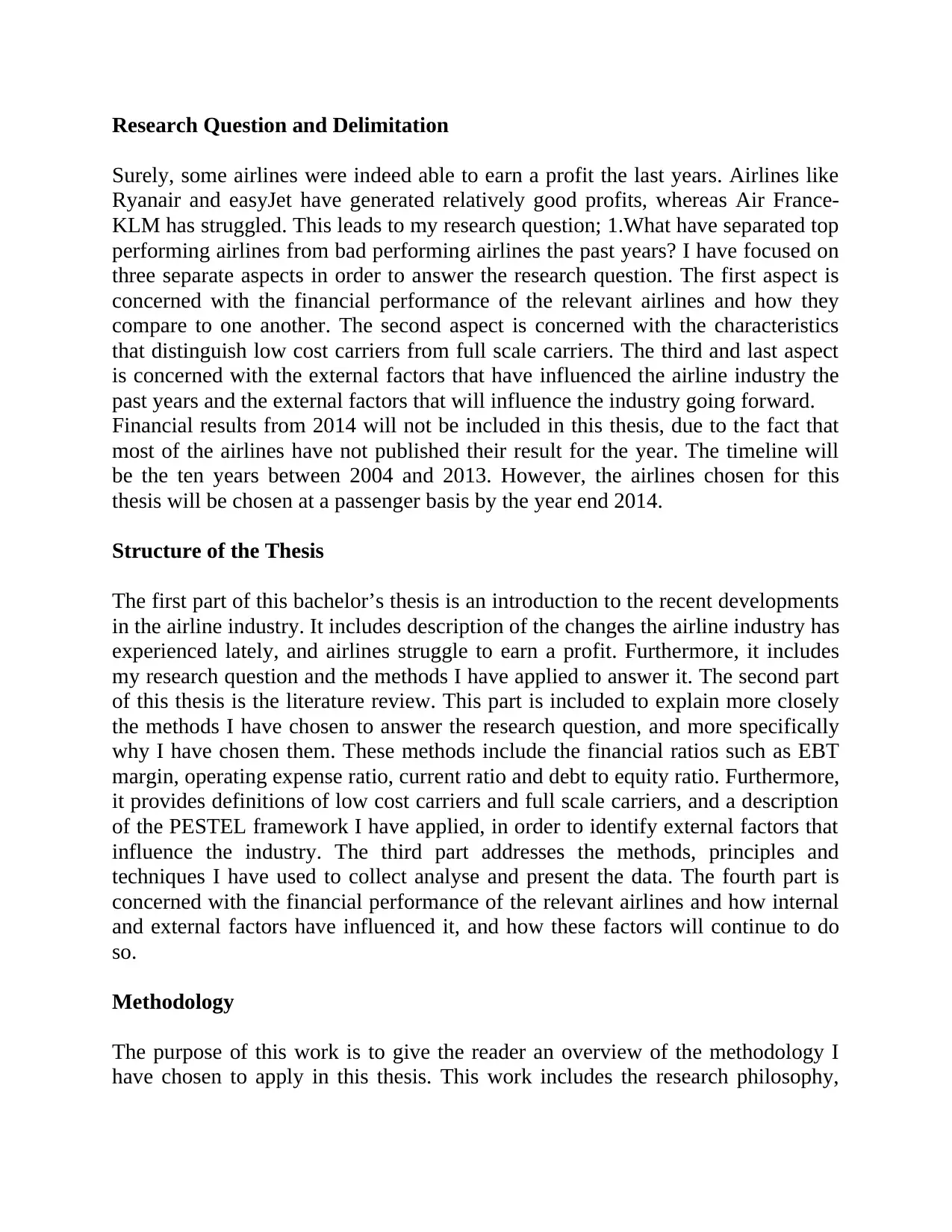
Research Question and Delimitation
Surely, some airlines were indeed able to earn a profit the last years. Airlines like
Ryanair and easyJet have generated relatively good profits, whereas Air France-
KLM has struggled. This leads to my research question; 1.What have separated top
performing airlines from bad performing airlines the past years? I have focused on
three separate aspects in order to answer the research question. The first aspect is
concerned with the financial performance of the relevant airlines and how they
compare to one another. The second aspect is concerned with the characteristics
that distinguish low cost carriers from full scale carriers. The third and last aspect
is concerned with the external factors that have influenced the airline industry the
past years and the external factors that will influence the industry going forward.
Financial results from 2014 will not be included in this thesis, due to the fact that
most of the airlines have not published their result for the year. The timeline will
be the ten years between 2004 and 2013. However, the airlines chosen for this
thesis will be chosen at a passenger basis by the year end 2014.
Structure of the Thesis
The first part of this bachelor’s thesis is an introduction to the recent developments
in the airline industry. It includes description of the changes the airline industry has
experienced lately, and airlines struggle to earn a profit. Furthermore, it includes
my research question and the methods I have applied to answer it. The second part
of this thesis is the literature review. This part is included to explain more closely
the methods I have chosen to answer the research question, and more specifically
why I have chosen them. These methods include the financial ratios such as EBT
margin, operating expense ratio, current ratio and debt to equity ratio. Furthermore,
it provides definitions of low cost carriers and full scale carriers, and a description
of the PESTEL framework I have applied, in order to identify external factors that
influence the industry. The third part addresses the methods, principles and
techniques I have used to collect analyse and present the data. The fourth part is
concerned with the financial performance of the relevant airlines and how internal
and external factors have influenced it, and how these factors will continue to do
so.
Methodology
The purpose of this work is to give the reader an overview of the methodology I
have chosen to apply in this thesis. This work includes the research philosophy,
Surely, some airlines were indeed able to earn a profit the last years. Airlines like
Ryanair and easyJet have generated relatively good profits, whereas Air France-
KLM has struggled. This leads to my research question; 1.What have separated top
performing airlines from bad performing airlines the past years? I have focused on
three separate aspects in order to answer the research question. The first aspect is
concerned with the financial performance of the relevant airlines and how they
compare to one another. The second aspect is concerned with the characteristics
that distinguish low cost carriers from full scale carriers. The third and last aspect
is concerned with the external factors that have influenced the airline industry the
past years and the external factors that will influence the industry going forward.
Financial results from 2014 will not be included in this thesis, due to the fact that
most of the airlines have not published their result for the year. The timeline will
be the ten years between 2004 and 2013. However, the airlines chosen for this
thesis will be chosen at a passenger basis by the year end 2014.
Structure of the Thesis
The first part of this bachelor’s thesis is an introduction to the recent developments
in the airline industry. It includes description of the changes the airline industry has
experienced lately, and airlines struggle to earn a profit. Furthermore, it includes
my research question and the methods I have applied to answer it. The second part
of this thesis is the literature review. This part is included to explain more closely
the methods I have chosen to answer the research question, and more specifically
why I have chosen them. These methods include the financial ratios such as EBT
margin, operating expense ratio, current ratio and debt to equity ratio. Furthermore,
it provides definitions of low cost carriers and full scale carriers, and a description
of the PESTEL framework I have applied, in order to identify external factors that
influence the industry. The third part addresses the methods, principles and
techniques I have used to collect analyse and present the data. The fourth part is
concerned with the financial performance of the relevant airlines and how internal
and external factors have influenced it, and how these factors will continue to do
so.
Methodology
The purpose of this work is to give the reader an overview of the methodology I
have chosen to apply in this thesis. This work includes the research philosophy,
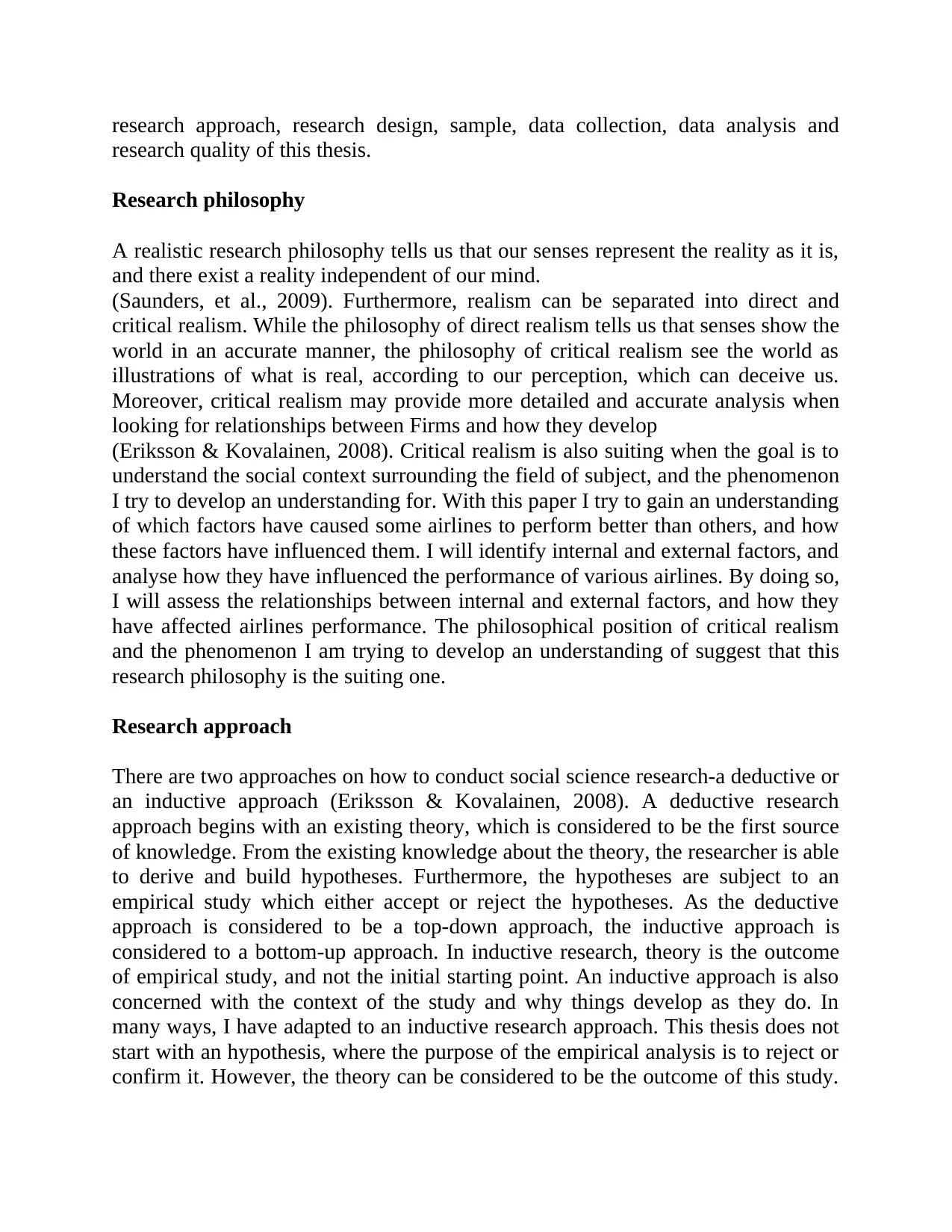
research approach, research design, sample, data collection, data analysis and
research quality of this thesis.
Research philosophy
A realistic research philosophy tells us that our senses represent the reality as it is,
and there exist a reality independent of our mind.
(Saunders, et al., 2009). Furthermore, realism can be separated into direct and
critical realism. While the philosophy of direct realism tells us that senses show the
world in an accurate manner, the philosophy of critical realism see the world as
illustrations of what is real, according to our perception, which can deceive us.
Moreover, critical realism may provide more detailed and accurate analysis when
looking for relationships between Firms and how they develop
(Eriksson & Kovalainen, 2008). Critical realism is also suiting when the goal is to
understand the social context surrounding the field of subject, and the phenomenon
I try to develop an understanding for. With this paper I try to gain an understanding
of which factors have caused some airlines to perform better than others, and how
these factors have influenced them. I will identify internal and external factors, and
analyse how they have influenced the performance of various airlines. By doing so,
I will assess the relationships between internal and external factors, and how they
have affected airlines performance. The philosophical position of critical realism
and the phenomenon I am trying to develop an understanding of suggest that this
research philosophy is the suiting one.
Research approach
There are two approaches on how to conduct social science research-a deductive or
an inductive approach (Eriksson & Kovalainen, 2008). A deductive research
approach begins with an existing theory, which is considered to be the first source
of knowledge. From the existing knowledge about the theory, the researcher is able
to derive and build hypotheses. Furthermore, the hypotheses are subject to an
empirical study which either accept or reject the hypotheses. As the deductive
approach is considered to be a top-down approach, the inductive approach is
considered to a bottom-up approach. In inductive research, theory is the outcome
of empirical study, and not the initial starting point. An inductive approach is also
concerned with the context of the study and why things develop as they do. In
many ways, I have adapted to an inductive research approach. This thesis does not
start with an hypothesis, where the purpose of the empirical analysis is to reject or
confirm it. However, the theory can be considered to be the outcome of this study.
research quality of this thesis.
Research philosophy
A realistic research philosophy tells us that our senses represent the reality as it is,
and there exist a reality independent of our mind.
(Saunders, et al., 2009). Furthermore, realism can be separated into direct and
critical realism. While the philosophy of direct realism tells us that senses show the
world in an accurate manner, the philosophy of critical realism see the world as
illustrations of what is real, according to our perception, which can deceive us.
Moreover, critical realism may provide more detailed and accurate analysis when
looking for relationships between Firms and how they develop
(Eriksson & Kovalainen, 2008). Critical realism is also suiting when the goal is to
understand the social context surrounding the field of subject, and the phenomenon
I try to develop an understanding for. With this paper I try to gain an understanding
of which factors have caused some airlines to perform better than others, and how
these factors have influenced them. I will identify internal and external factors, and
analyse how they have influenced the performance of various airlines. By doing so,
I will assess the relationships between internal and external factors, and how they
have affected airlines performance. The philosophical position of critical realism
and the phenomenon I am trying to develop an understanding of suggest that this
research philosophy is the suiting one.
Research approach
There are two approaches on how to conduct social science research-a deductive or
an inductive approach (Eriksson & Kovalainen, 2008). A deductive research
approach begins with an existing theory, which is considered to be the first source
of knowledge. From the existing knowledge about the theory, the researcher is able
to derive and build hypotheses. Furthermore, the hypotheses are subject to an
empirical study which either accept or reject the hypotheses. As the deductive
approach is considered to be a top-down approach, the inductive approach is
considered to a bottom-up approach. In inductive research, theory is the outcome
of empirical study, and not the initial starting point. An inductive approach is also
concerned with the context of the study and why things develop as they do. In
many ways, I have adapted to an inductive research approach. This thesis does not
start with an hypothesis, where the purpose of the empirical analysis is to reject or
confirm it. However, the theory can be considered to be the outcome of this study.
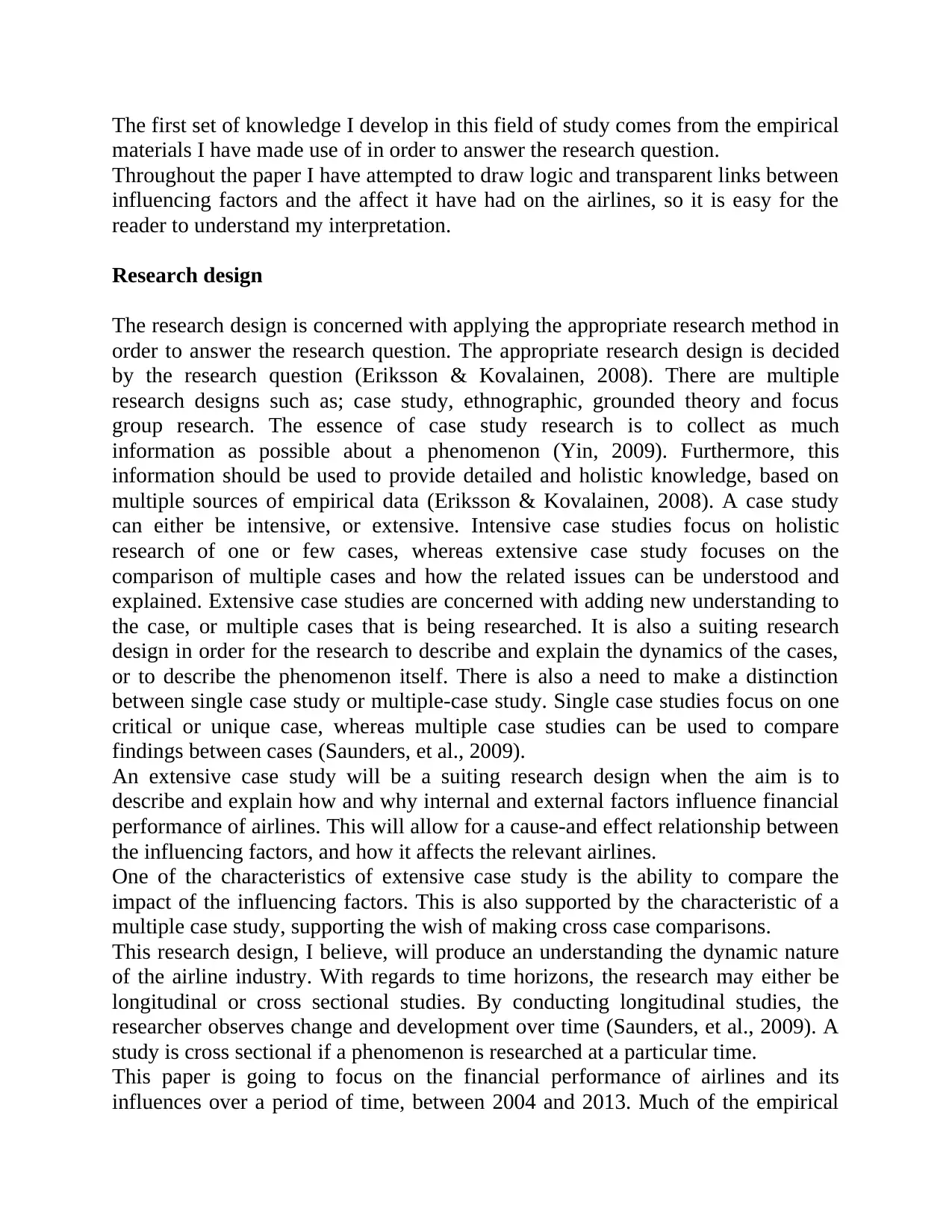
The first set of knowledge I develop in this field of study comes from the empirical
materials I have made use of in order to answer the research question.
Throughout the paper I have attempted to draw logic and transparent links between
influencing factors and the affect it have had on the airlines, so it is easy for the
reader to understand my interpretation.
Research design
The research design is concerned with applying the appropriate research method in
order to answer the research question. The appropriate research design is decided
by the research question (Eriksson & Kovalainen, 2008). There are multiple
research designs such as; case study, ethnographic, grounded theory and focus
group research. The essence of case study research is to collect as much
information as possible about a phenomenon (Yin, 2009). Furthermore, this
information should be used to provide detailed and holistic knowledge, based on
multiple sources of empirical data (Eriksson & Kovalainen, 2008). A case study
can either be intensive, or extensive. Intensive case studies focus on holistic
research of one or few cases, whereas extensive case study focuses on the
comparison of multiple cases and how the related issues can be understood and
explained. Extensive case studies are concerned with adding new understanding to
the case, or multiple cases that is being researched. It is also a suiting research
design in order for the research to describe and explain the dynamics of the cases,
or to describe the phenomenon itself. There is also a need to make a distinction
between single case study or multiple-case study. Single case studies focus on one
critical or unique case, whereas multiple case studies can be used to compare
findings between cases (Saunders, et al., 2009).
An extensive case study will be a suiting research design when the aim is to
describe and explain how and why internal and external factors influence financial
performance of airlines. This will allow for a cause-and effect relationship between
the influencing factors, and how it affects the relevant airlines.
One of the characteristics of extensive case study is the ability to compare the
impact of the influencing factors. This is also supported by the characteristic of a
multiple case study, supporting the wish of making cross case comparisons.
This research design, I believe, will produce an understanding the dynamic nature
of the airline industry. With regards to time horizons, the research may either be
longitudinal or cross sectional studies. By conducting longitudinal studies, the
researcher observes change and development over time (Saunders, et al., 2009). A
study is cross sectional if a phenomenon is researched at a particular time.
This paper is going to focus on the financial performance of airlines and its
influences over a period of time, between 2004 and 2013. Much of the empirical
materials I have made use of in order to answer the research question.
Throughout the paper I have attempted to draw logic and transparent links between
influencing factors and the affect it have had on the airlines, so it is easy for the
reader to understand my interpretation.
Research design
The research design is concerned with applying the appropriate research method in
order to answer the research question. The appropriate research design is decided
by the research question (Eriksson & Kovalainen, 2008). There are multiple
research designs such as; case study, ethnographic, grounded theory and focus
group research. The essence of case study research is to collect as much
information as possible about a phenomenon (Yin, 2009). Furthermore, this
information should be used to provide detailed and holistic knowledge, based on
multiple sources of empirical data (Eriksson & Kovalainen, 2008). A case study
can either be intensive, or extensive. Intensive case studies focus on holistic
research of one or few cases, whereas extensive case study focuses on the
comparison of multiple cases and how the related issues can be understood and
explained. Extensive case studies are concerned with adding new understanding to
the case, or multiple cases that is being researched. It is also a suiting research
design in order for the research to describe and explain the dynamics of the cases,
or to describe the phenomenon itself. There is also a need to make a distinction
between single case study or multiple-case study. Single case studies focus on one
critical or unique case, whereas multiple case studies can be used to compare
findings between cases (Saunders, et al., 2009).
An extensive case study will be a suiting research design when the aim is to
describe and explain how and why internal and external factors influence financial
performance of airlines. This will allow for a cause-and effect relationship between
the influencing factors, and how it affects the relevant airlines.
One of the characteristics of extensive case study is the ability to compare the
impact of the influencing factors. This is also supported by the characteristic of a
multiple case study, supporting the wish of making cross case comparisons.
This research design, I believe, will produce an understanding the dynamic nature
of the airline industry. With regards to time horizons, the research may either be
longitudinal or cross sectional studies. By conducting longitudinal studies, the
researcher observes change and development over time (Saunders, et al., 2009). A
study is cross sectional if a phenomenon is researched at a particular time.
This paper is going to focus on the financial performance of airlines and its
influences over a period of time, between 2004 and 2013. Much of the empirical
Secure Best Marks with AI Grader
Need help grading? Try our AI Grader for instant feedback on your assignments.
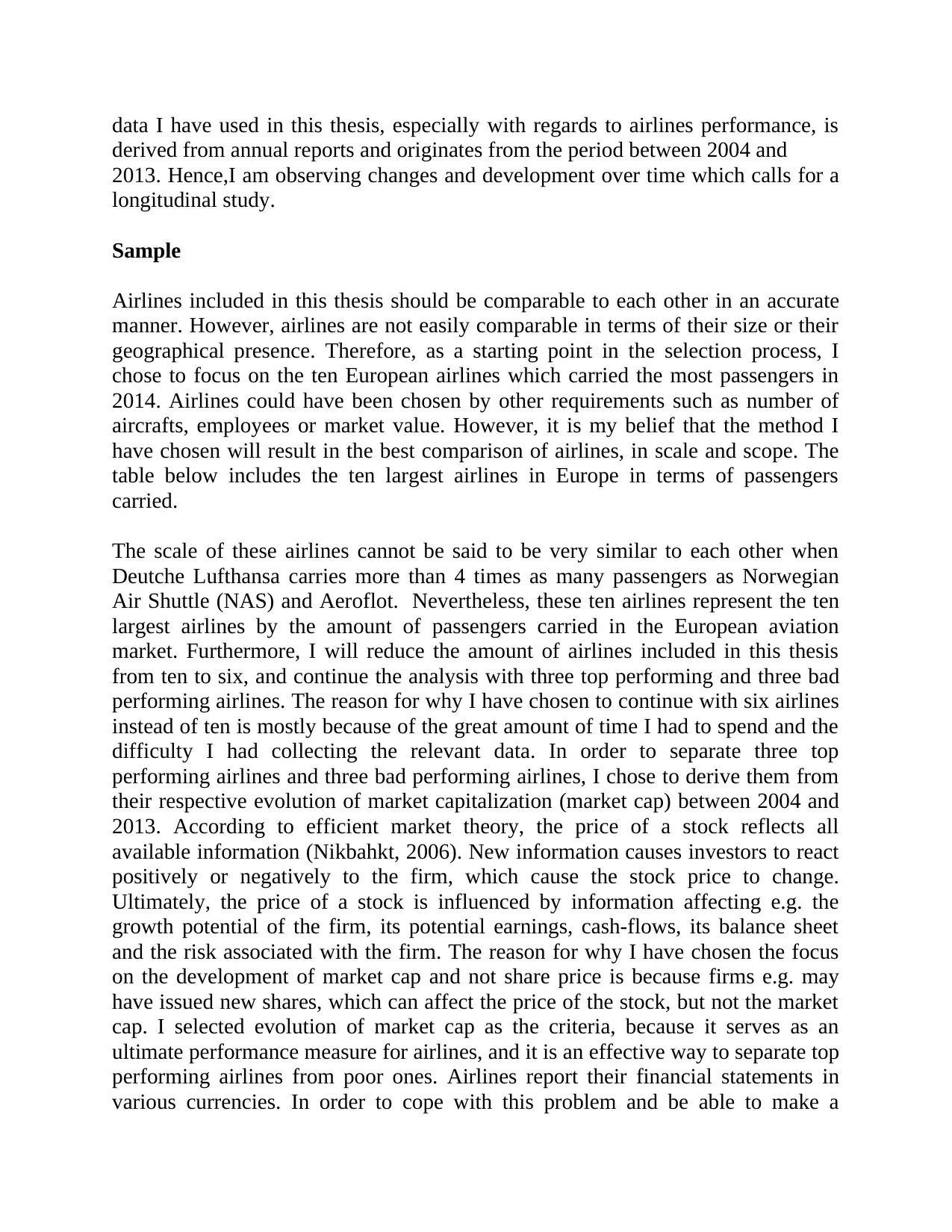
data I have used in this thesis, especially with regards to airlines performance, is
derived from annual reports and originates from the period between 2004 and
2013. Hence,I am observing changes and development over time which calls for a
longitudinal study.
Sample
Airlines included in this thesis should be comparable to each other in an accurate
manner. However, airlines are not easily comparable in terms of their size or their
geographical presence. Therefore, as a starting point in the selection process, I
chose to focus on the ten European airlines which carried the most passengers in
2014. Airlines could have been chosen by other requirements such as number of
aircrafts, employees or market value. However, it is my belief that the method I
have chosen will result in the best comparison of airlines, in scale and scope. The
table below includes the ten largest airlines in Europe in terms of passengers
carried.
The scale of these airlines cannot be said to be very similar to each other when
Deutche Lufthansa carries more than 4 times as many passengers as Norwegian
Air Shuttle (NAS) and Aeroflot. Nevertheless, these ten airlines represent the ten
largest airlines by the amount of passengers carried in the European aviation
market. Furthermore, I will reduce the amount of airlines included in this thesis
from ten to six, and continue the analysis with three top performing and three bad
performing airlines. The reason for why I have chosen to continue with six airlines
instead of ten is mostly because of the great amount of time I had to spend and the
difficulty I had collecting the relevant data. In order to separate three top
performing airlines and three bad performing airlines, I chose to derive them from
their respective evolution of market capitalization (market cap) between 2004 and
2013. According to efficient market theory, the price of a stock reflects all
available information (Nikbahkt, 2006). New information causes investors to react
positively or negatively to the firm, which cause the stock price to change.
Ultimately, the price of a stock is influenced by information affecting e.g. the
growth potential of the firm, its potential earnings, cash-flows, its balance sheet
and the risk associated with the firm. The reason for why I have chosen the focus
on the development of market cap and not share price is because firms e.g. may
have issued new shares, which can affect the price of the stock, but not the market
cap. I selected evolution of market cap as the criteria, because it serves as an
ultimate performance measure for airlines, and it is an effective way to separate top
performing airlines from poor ones. Airlines report their financial statements in
various currencies. In order to cope with this problem and be able to make a
derived from annual reports and originates from the period between 2004 and
2013. Hence,I am observing changes and development over time which calls for a
longitudinal study.
Sample
Airlines included in this thesis should be comparable to each other in an accurate
manner. However, airlines are not easily comparable in terms of their size or their
geographical presence. Therefore, as a starting point in the selection process, I
chose to focus on the ten European airlines which carried the most passengers in
2014. Airlines could have been chosen by other requirements such as number of
aircrafts, employees or market value. However, it is my belief that the method I
have chosen will result in the best comparison of airlines, in scale and scope. The
table below includes the ten largest airlines in Europe in terms of passengers
carried.
The scale of these airlines cannot be said to be very similar to each other when
Deutche Lufthansa carries more than 4 times as many passengers as Norwegian
Air Shuttle (NAS) and Aeroflot. Nevertheless, these ten airlines represent the ten
largest airlines by the amount of passengers carried in the European aviation
market. Furthermore, I will reduce the amount of airlines included in this thesis
from ten to six, and continue the analysis with three top performing and three bad
performing airlines. The reason for why I have chosen to continue with six airlines
instead of ten is mostly because of the great amount of time I had to spend and the
difficulty I had collecting the relevant data. In order to separate three top
performing airlines and three bad performing airlines, I chose to derive them from
their respective evolution of market capitalization (market cap) between 2004 and
2013. According to efficient market theory, the price of a stock reflects all
available information (Nikbahkt, 2006). New information causes investors to react
positively or negatively to the firm, which cause the stock price to change.
Ultimately, the price of a stock is influenced by information affecting e.g. the
growth potential of the firm, its potential earnings, cash-flows, its balance sheet
and the risk associated with the firm. The reason for why I have chosen the focus
on the development of market cap and not share price is because firms e.g. may
have issued new shares, which can affect the price of the stock, but not the market
cap. I selected evolution of market cap as the criteria, because it serves as an
ultimate performance measure for airlines, and it is an effective way to separate top
performing airlines from poor ones. Airlines report their financial statements in
various currencies. In order to cope with this problem and be able to make a

precise comparison, all financial data will be converted into euros. Five of the
airlines report in euros, whereas the rest of them British pounds, Swedish krona,
Norwegian krona, US dollar and Russian rouble. The relevant exchange rates have
been chosen by the date of which their financial year ends.
Another issue when comparing the financial performance of these airlines is that
they have adopted different financial years. A firm’s financial year is the period in
which it reports its annual financial results, and can vary between firms
I realize the limitation of comparing data from the airlines annual financial report
when they do not cover the same period.
Data collection:
There are two different types of data, qualitative and quantitative
(Eriksson & Kovalainen, 2008). Quantitative data consist of numeric data, whereas
qualitative data consist of non-numeric data. Simply put, qualitative data often
include words, but can also include e.g. diagrams and pictures. Quantitative data
on the other hand consist of information that can be measured in numbers.
Furthermore, empirical data used in research can be divided into primary and
secondary data. Empirical data is considered to be primary when the researcher has
collected the data themselves. However, empirical data that already exists is called
secondary data. Primary data can be collected through e.g. interviews or
experiments, whereas secondary data can be collected from e.g. research papers,
journals and annual reports. This thesis has used qualitative and quantitative
secondary data, which have some advantages.
An advantage with secondary data is that I can evaluate the data to see if it is
relevant prior to me using them (Saunders, et al., 2009). Secondary data is often
retrieved from public sources; hence it is easy for many to check this information.
This means that the data is likely to be criticized, and corrected if they are wrong.
However, the use of secondary data has some disadvantages as well. Data is
collected in order to answer a research question. Secondary data that I collect, may
have been collected to answer another research question than I aim to answer, thus
the data can be inappropriate. Secondary data may have been collected some years
ago, thus perhaps making it less relevant. Another important disadvantage is that I
lose control over the quality of the data. Even though much of the secondary data I
have collected is existing empirical data, that origin from government agencies
such as Eurostat, industry organizations like International Air Transportation
Association (IATA) and annual reports I cannot be certain the data is of high
quality. In addition to this, information is gathered from consultancy agencies such
as Boston Consulting Group (BCG), journals from e.g. Journal of Air
airlines report in euros, whereas the rest of them British pounds, Swedish krona,
Norwegian krona, US dollar and Russian rouble. The relevant exchange rates have
been chosen by the date of which their financial year ends.
Another issue when comparing the financial performance of these airlines is that
they have adopted different financial years. A firm’s financial year is the period in
which it reports its annual financial results, and can vary between firms
I realize the limitation of comparing data from the airlines annual financial report
when they do not cover the same period.
Data collection:
There are two different types of data, qualitative and quantitative
(Eriksson & Kovalainen, 2008). Quantitative data consist of numeric data, whereas
qualitative data consist of non-numeric data. Simply put, qualitative data often
include words, but can also include e.g. diagrams and pictures. Quantitative data
on the other hand consist of information that can be measured in numbers.
Furthermore, empirical data used in research can be divided into primary and
secondary data. Empirical data is considered to be primary when the researcher has
collected the data themselves. However, empirical data that already exists is called
secondary data. Primary data can be collected through e.g. interviews or
experiments, whereas secondary data can be collected from e.g. research papers,
journals and annual reports. This thesis has used qualitative and quantitative
secondary data, which have some advantages.
An advantage with secondary data is that I can evaluate the data to see if it is
relevant prior to me using them (Saunders, et al., 2009). Secondary data is often
retrieved from public sources; hence it is easy for many to check this information.
This means that the data is likely to be criticized, and corrected if they are wrong.
However, the use of secondary data has some disadvantages as well. Data is
collected in order to answer a research question. Secondary data that I collect, may
have been collected to answer another research question than I aim to answer, thus
the data can be inappropriate. Secondary data may have been collected some years
ago, thus perhaps making it less relevant. Another important disadvantage is that I
lose control over the quality of the data. Even though much of the secondary data I
have collected is existing empirical data, that origin from government agencies
such as Eurostat, industry organizations like International Air Transportation
Association (IATA) and annual reports I cannot be certain the data is of high
quality. In addition to this, information is gathered from consultancy agencies such
as Boston Consulting Group (BCG), journals from e.g. Journal of Air
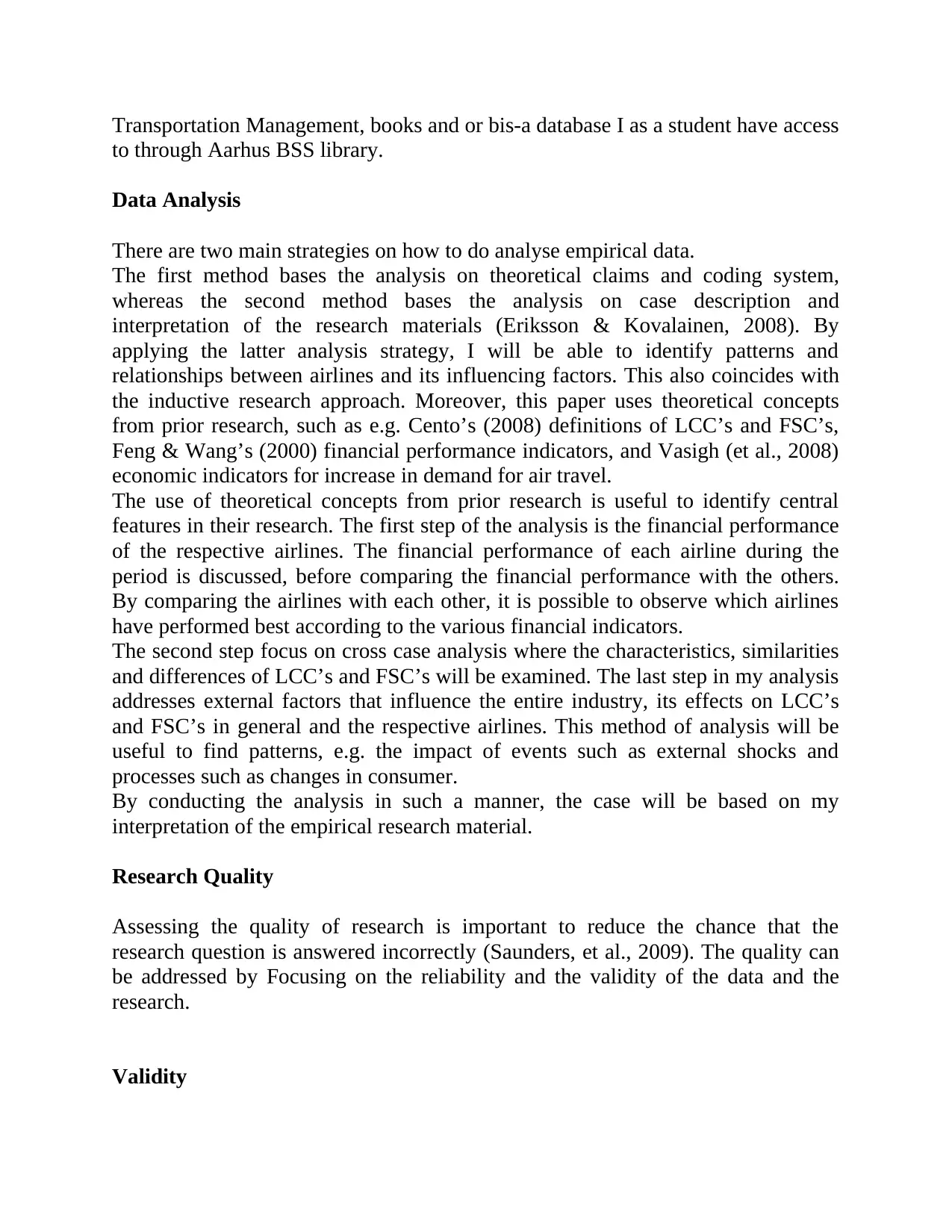
Transportation Management, books and or bis-a database I as a student have access
to through Aarhus BSS library.
Data Analysis
There are two main strategies on how to do analyse empirical data.
The first method bases the analysis on theoretical claims and coding system,
whereas the second method bases the analysis on case description and
interpretation of the research materials (Eriksson & Kovalainen, 2008). By
applying the latter analysis strategy, I will be able to identify patterns and
relationships between airlines and its influencing factors. This also coincides with
the inductive research approach. Moreover, this paper uses theoretical concepts
from prior research, such as e.g. Cento’s (2008) definitions of LCC’s and FSC’s,
Feng & Wang’s (2000) financial performance indicators, and Vasigh (et al., 2008)
economic indicators for increase in demand for air travel.
The use of theoretical concepts from prior research is useful to identify central
features in their research. The first step of the analysis is the financial performance
of the respective airlines. The financial performance of each airline during the
period is discussed, before comparing the financial performance with the others.
By comparing the airlines with each other, it is possible to observe which airlines
have performed best according to the various financial indicators.
The second step focus on cross case analysis where the characteristics, similarities
and differences of LCC’s and FSC’s will be examined. The last step in my analysis
addresses external factors that influence the entire industry, its effects on LCC’s
and FSC’s in general and the respective airlines. This method of analysis will be
useful to find patterns, e.g. the impact of events such as external shocks and
processes such as changes in consumer.
By conducting the analysis in such a manner, the case will be based on my
interpretation of the empirical research material.
Research Quality
Assessing the quality of research is important to reduce the chance that the
research question is answered incorrectly (Saunders, et al., 2009). The quality can
be addressed by Focusing on the reliability and the validity of the data and the
research.
Validity
to through Aarhus BSS library.
Data Analysis
There are two main strategies on how to do analyse empirical data.
The first method bases the analysis on theoretical claims and coding system,
whereas the second method bases the analysis on case description and
interpretation of the research materials (Eriksson & Kovalainen, 2008). By
applying the latter analysis strategy, I will be able to identify patterns and
relationships between airlines and its influencing factors. This also coincides with
the inductive research approach. Moreover, this paper uses theoretical concepts
from prior research, such as e.g. Cento’s (2008) definitions of LCC’s and FSC’s,
Feng & Wang’s (2000) financial performance indicators, and Vasigh (et al., 2008)
economic indicators for increase in demand for air travel.
The use of theoretical concepts from prior research is useful to identify central
features in their research. The first step of the analysis is the financial performance
of the respective airlines. The financial performance of each airline during the
period is discussed, before comparing the financial performance with the others.
By comparing the airlines with each other, it is possible to observe which airlines
have performed best according to the various financial indicators.
The second step focus on cross case analysis where the characteristics, similarities
and differences of LCC’s and FSC’s will be examined. The last step in my analysis
addresses external factors that influence the entire industry, its effects on LCC’s
and FSC’s in general and the respective airlines. This method of analysis will be
useful to find patterns, e.g. the impact of events such as external shocks and
processes such as changes in consumer.
By conducting the analysis in such a manner, the case will be based on my
interpretation of the empirical research material.
Research Quality
Assessing the quality of research is important to reduce the chance that the
research question is answered incorrectly (Saunders, et al., 2009). The quality can
be addressed by Focusing on the reliability and the validity of the data and the
research.
Validity
Paraphrase This Document
Need a fresh take? Get an instant paraphrase of this document with our AI Paraphraser
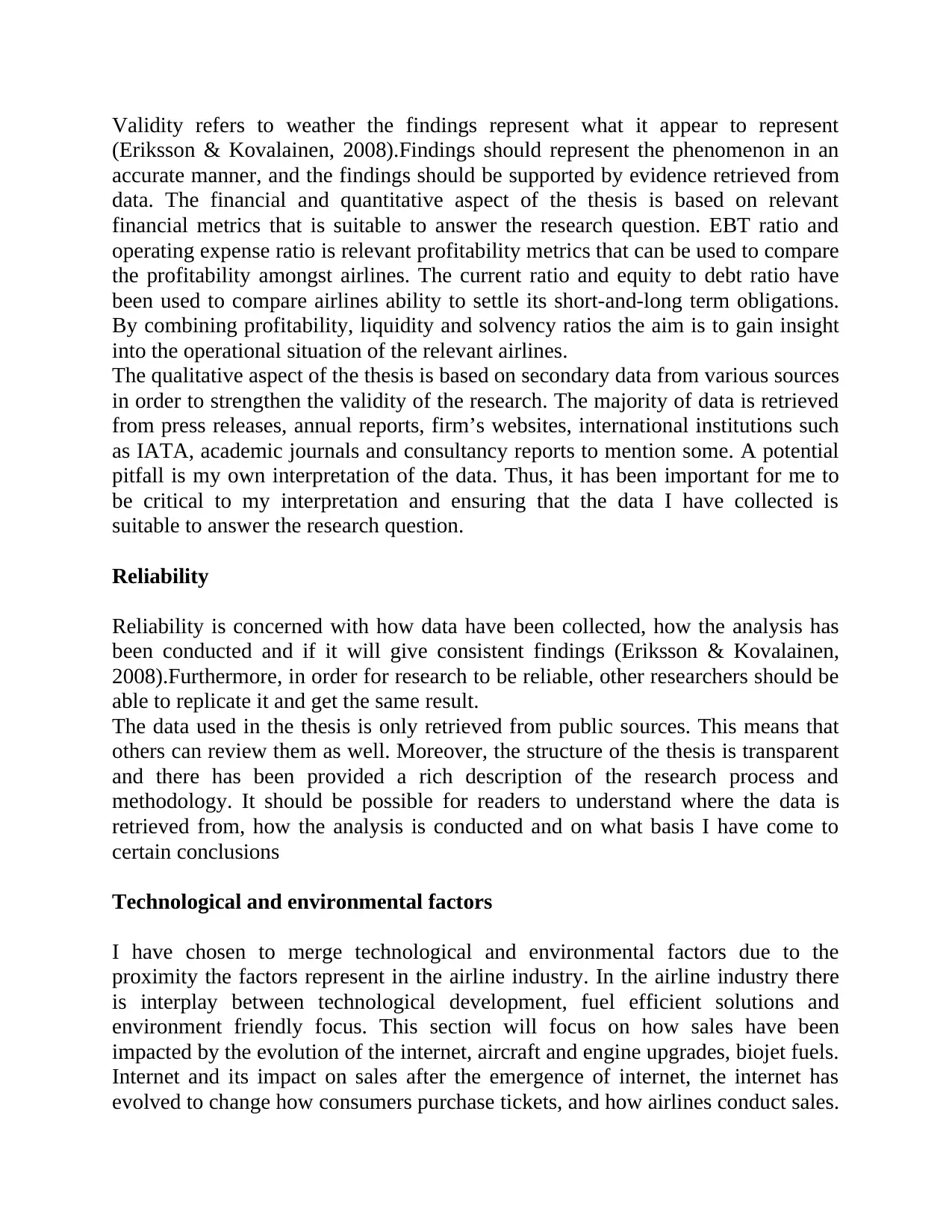
Validity refers to weather the findings represent what it appear to represent
(Eriksson & Kovalainen, 2008).Findings should represent the phenomenon in an
accurate manner, and the findings should be supported by evidence retrieved from
data. The financial and quantitative aspect of the thesis is based on relevant
financial metrics that is suitable to answer the research question. EBT ratio and
operating expense ratio is relevant profitability metrics that can be used to compare
the profitability amongst airlines. The current ratio and equity to debt ratio have
been used to compare airlines ability to settle its short-and-long term obligations.
By combining profitability, liquidity and solvency ratios the aim is to gain insight
into the operational situation of the relevant airlines.
The qualitative aspect of the thesis is based on secondary data from various sources
in order to strengthen the validity of the research. The majority of data is retrieved
from press releases, annual reports, firm’s websites, international institutions such
as IATA, academic journals and consultancy reports to mention some. A potential
pitfall is my own interpretation of the data. Thus, it has been important for me to
be critical to my interpretation and ensuring that the data I have collected is
suitable to answer the research question.
Reliability
Reliability is concerned with how data have been collected, how the analysis has
been conducted and if it will give consistent findings (Eriksson & Kovalainen,
2008).Furthermore, in order for research to be reliable, other researchers should be
able to replicate it and get the same result.
The data used in the thesis is only retrieved from public sources. This means that
others can review them as well. Moreover, the structure of the thesis is transparent
and there has been provided a rich description of the research process and
methodology. It should be possible for readers to understand where the data is
retrieved from, how the analysis is conducted and on what basis I have come to
certain conclusions
Technological and environmental factors
I have chosen to merge technological and environmental factors due to the
proximity the factors represent in the airline industry. In the airline industry there
is interplay between technological development, fuel efficient solutions and
environment friendly focus. This section will focus on how sales have been
impacted by the evolution of the internet, aircraft and engine upgrades, biojet fuels.
Internet and its impact on sales after the emergence of internet, the internet has
evolved to change how consumers purchase tickets, and how airlines conduct sales.
(Eriksson & Kovalainen, 2008).Findings should represent the phenomenon in an
accurate manner, and the findings should be supported by evidence retrieved from
data. The financial and quantitative aspect of the thesis is based on relevant
financial metrics that is suitable to answer the research question. EBT ratio and
operating expense ratio is relevant profitability metrics that can be used to compare
the profitability amongst airlines. The current ratio and equity to debt ratio have
been used to compare airlines ability to settle its short-and-long term obligations.
By combining profitability, liquidity and solvency ratios the aim is to gain insight
into the operational situation of the relevant airlines.
The qualitative aspect of the thesis is based on secondary data from various sources
in order to strengthen the validity of the research. The majority of data is retrieved
from press releases, annual reports, firm’s websites, international institutions such
as IATA, academic journals and consultancy reports to mention some. A potential
pitfall is my own interpretation of the data. Thus, it has been important for me to
be critical to my interpretation and ensuring that the data I have collected is
suitable to answer the research question.
Reliability
Reliability is concerned with how data have been collected, how the analysis has
been conducted and if it will give consistent findings (Eriksson & Kovalainen,
2008).Furthermore, in order for research to be reliable, other researchers should be
able to replicate it and get the same result.
The data used in the thesis is only retrieved from public sources. This means that
others can review them as well. Moreover, the structure of the thesis is transparent
and there has been provided a rich description of the research process and
methodology. It should be possible for readers to understand where the data is
retrieved from, how the analysis is conducted and on what basis I have come to
certain conclusions
Technological and environmental factors
I have chosen to merge technological and environmental factors due to the
proximity the factors represent in the airline industry. In the airline industry there
is interplay between technological development, fuel efficient solutions and
environment friendly focus. This section will focus on how sales have been
impacted by the evolution of the internet, aircraft and engine upgrades, biojet fuels.
Internet and its impact on sales after the emergence of internet, the internet has
evolved to change how consumers purchase tickets, and how airlines conduct sales.
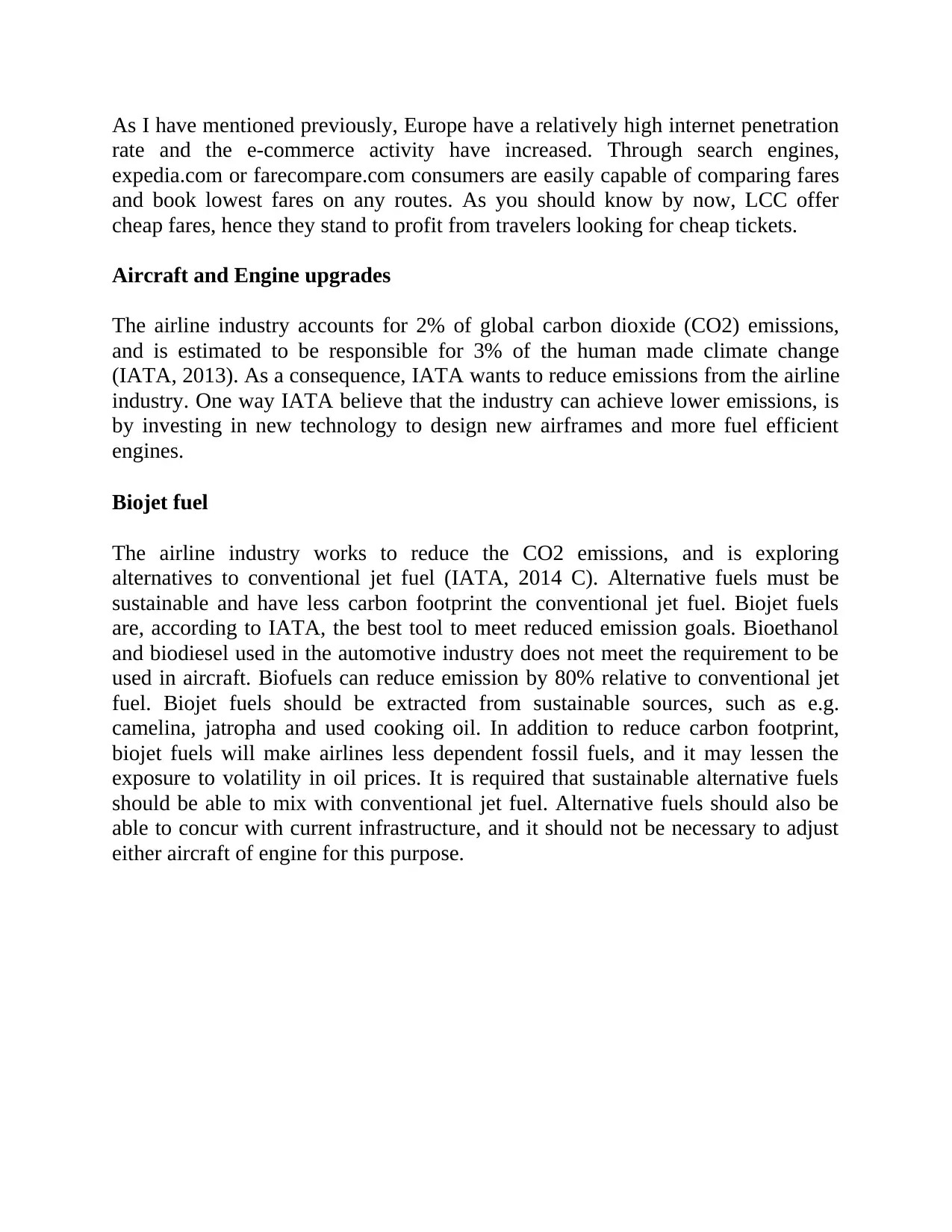
As I have mentioned previously, Europe have a relatively high internet penetration
rate and the e-commerce activity have increased. Through search engines,
expedia.com or farecompare.com consumers are easily capable of comparing fares
and book lowest fares on any routes. As you should know by now, LCC offer
cheap fares, hence they stand to profit from travelers looking for cheap tickets.
Aircraft and Engine upgrades
The airline industry accounts for 2% of global carbon dioxide (CO2) emissions,
and is estimated to be responsible for 3% of the human made climate change
(IATA, 2013). As a consequence, IATA wants to reduce emissions from the airline
industry. One way IATA believe that the industry can achieve lower emissions, is
by investing in new technology to design new airframes and more fuel efficient
engines.
Biojet fuel
The airline industry works to reduce the CO2 emissions, and is exploring
alternatives to conventional jet fuel (IATA, 2014 C). Alternative fuels must be
sustainable and have less carbon footprint the conventional jet fuel. Biojet fuels
are, according to IATA, the best tool to meet reduced emission goals. Bioethanol
and biodiesel used in the automotive industry does not meet the requirement to be
used in aircraft. Biofuels can reduce emission by 80% relative to conventional jet
fuel. Biojet fuels should be extracted from sustainable sources, such as e.g.
camelina, jatropha and used cooking oil. In addition to reduce carbon footprint,
biojet fuels will make airlines less dependent fossil fuels, and it may lessen the
exposure to volatility in oil prices. It is required that sustainable alternative fuels
should be able to mix with conventional jet fuel. Alternative fuels should also be
able to concur with current infrastructure, and it should not be necessary to adjust
either aircraft of engine for this purpose.
rate and the e-commerce activity have increased. Through search engines,
expedia.com or farecompare.com consumers are easily capable of comparing fares
and book lowest fares on any routes. As you should know by now, LCC offer
cheap fares, hence they stand to profit from travelers looking for cheap tickets.
Aircraft and Engine upgrades
The airline industry accounts for 2% of global carbon dioxide (CO2) emissions,
and is estimated to be responsible for 3% of the human made climate change
(IATA, 2013). As a consequence, IATA wants to reduce emissions from the airline
industry. One way IATA believe that the industry can achieve lower emissions, is
by investing in new technology to design new airframes and more fuel efficient
engines.
Biojet fuel
The airline industry works to reduce the CO2 emissions, and is exploring
alternatives to conventional jet fuel (IATA, 2014 C). Alternative fuels must be
sustainable and have less carbon footprint the conventional jet fuel. Biojet fuels
are, according to IATA, the best tool to meet reduced emission goals. Bioethanol
and biodiesel used in the automotive industry does not meet the requirement to be
used in aircraft. Biofuels can reduce emission by 80% relative to conventional jet
fuel. Biojet fuels should be extracted from sustainable sources, such as e.g.
camelina, jatropha and used cooking oil. In addition to reduce carbon footprint,
biojet fuels will make airlines less dependent fossil fuels, and it may lessen the
exposure to volatility in oil prices. It is required that sustainable alternative fuels
should be able to mix with conventional jet fuel. Alternative fuels should also be
able to concur with current infrastructure, and it should not be necessary to adjust
either aircraft of engine for this purpose.
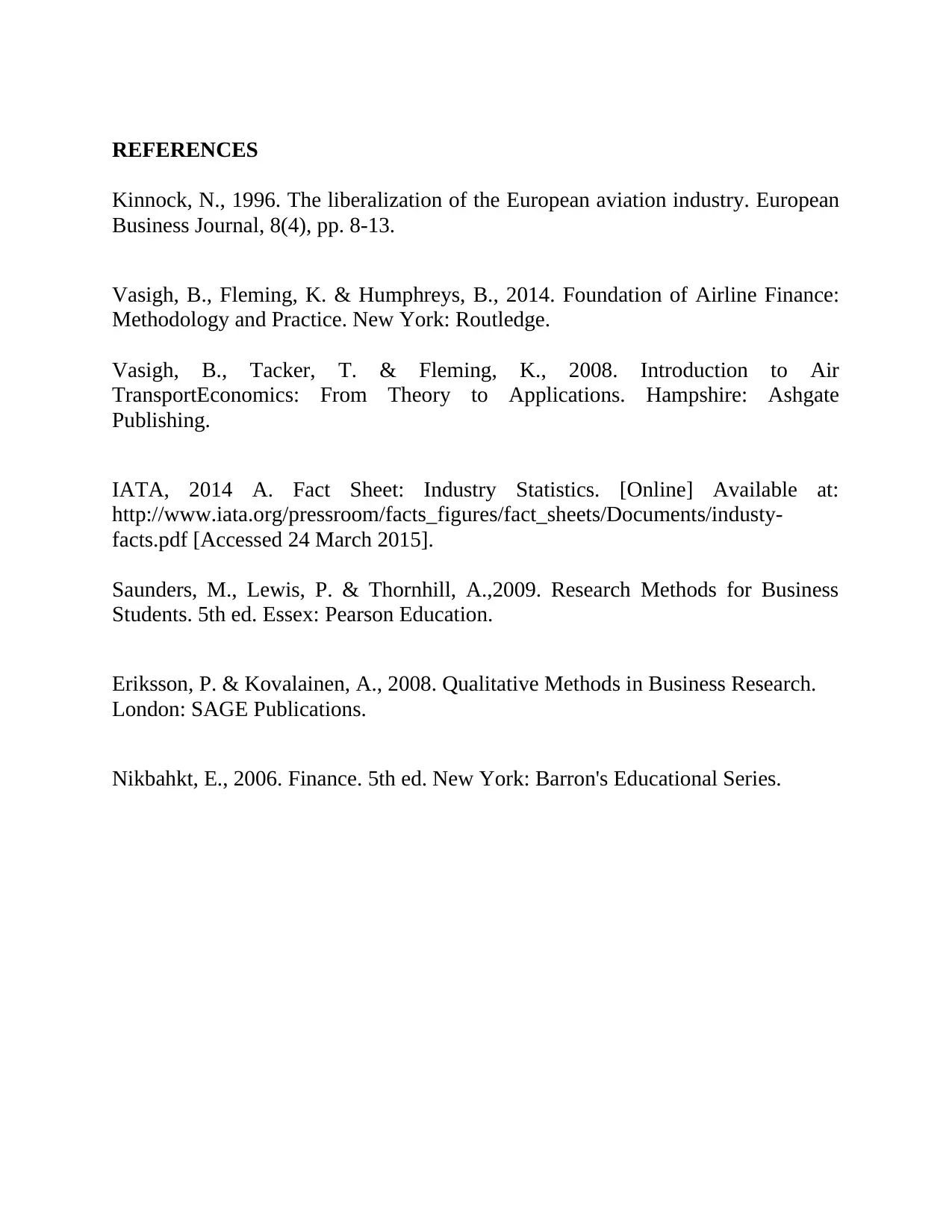
REFERENCES
Kinnock, N., 1996. The liberalization of the European aviation industry. European
Business Journal, 8(4), pp. 8-13.
Vasigh, B., Fleming, K. & Humphreys, B., 2014. Foundation of Airline Finance:
Methodology and Practice. New York: Routledge.
Vasigh, B., Tacker, T. & Fleming, K., 2008. Introduction to Air
TransportEconomics: From Theory to Applications. Hampshire: Ashgate
Publishing.
IATA, 2014 A. Fact Sheet: Industry Statistics. [Online] Available at:
http://www.iata.org/pressroom/facts_figures/fact_sheets/Documents/industy-
facts.pdf [Accessed 24 March 2015].
Saunders, M., Lewis, P. & Thornhill, A.,2009. Research Methods for Business
Students. 5th ed. Essex: Pearson Education.
Eriksson, P. & Kovalainen, A., 2008. Qualitative Methods in Business Research.
London: SAGE Publications.
Nikbahkt, E., 2006. Finance. 5th ed. New York: Barron's Educational Series.
Kinnock, N., 1996. The liberalization of the European aviation industry. European
Business Journal, 8(4), pp. 8-13.
Vasigh, B., Fleming, K. & Humphreys, B., 2014. Foundation of Airline Finance:
Methodology and Practice. New York: Routledge.
Vasigh, B., Tacker, T. & Fleming, K., 2008. Introduction to Air
TransportEconomics: From Theory to Applications. Hampshire: Ashgate
Publishing.
IATA, 2014 A. Fact Sheet: Industry Statistics. [Online] Available at:
http://www.iata.org/pressroom/facts_figures/fact_sheets/Documents/industy-
facts.pdf [Accessed 24 March 2015].
Saunders, M., Lewis, P. & Thornhill, A.,2009. Research Methods for Business
Students. 5th ed. Essex: Pearson Education.
Eriksson, P. & Kovalainen, A., 2008. Qualitative Methods in Business Research.
London: SAGE Publications.
Nikbahkt, E., 2006. Finance. 5th ed. New York: Barron's Educational Series.
1 out of 10
Related Documents
Your All-in-One AI-Powered Toolkit for Academic Success.
+13062052269
info@desklib.com
Available 24*7 on WhatsApp / Email
![[object Object]](/_next/static/media/star-bottom.7253800d.svg)
Unlock your academic potential
© 2024 | Zucol Services PVT LTD | All rights reserved.





